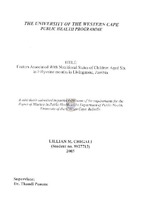| dc.description.abstract | A matched case-control study was carried out to identify the factors associated with the nutritional status of children in Livingstone district, Zambia. A trained field researcher collected data on demographic, feeding practices and socio-economic factors in matched groups of underweight children and normal weight children from the mothers/caregivers of the children. Interviews, using a structured pre-tested questionnaire, were used to obtain the data. All children aged from six to fifty-nine months admitted at Livingstone General Hospital during the months of October to December, 2003 with a weight for age below –2SD from the median of the reference population formed the underweight children (cases). The total was 47 children. The cases were then matched according to sex and age to 47 normal weight children attending the under five clinic at Livingstone General Hospital during the same months, with a weight for age above –2SD from the median of the reference population (controls). The final sample was 94 children. Weights were recorded using the same scale in the outpatient’s department prior to admission and during the under five clinic session. Interviews then took place in a separate room after the clinic nurse had attended them. A separate visit was then made to the homes of the children on a different day. Odds ratios and 95% confidence intervals were used to measure strengths of associations. Results revealed that the basic causes of underweight were the poor economic state of the country, unfavorable policies and insufficient government support in the areas of health, education, agriculture, housing and employment. Underlying causes were inadequate access to food, inadequate care of children, poor access to health services and unhealthy living environments, while immediate causes were poor food intake and disease. Low educational and literacy levels of the mothers/caregivers, unemployment and lack of sufficient finances to access basic necessities such as food, housing and health contributed to underweight. | en_US |

